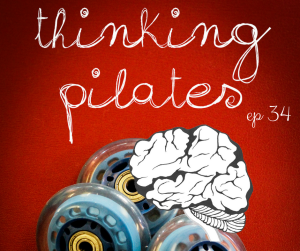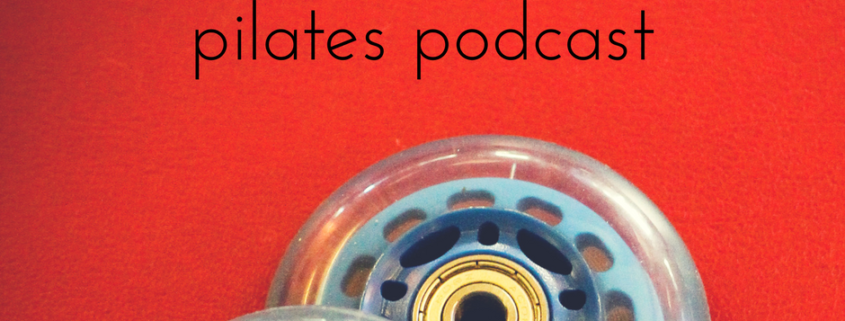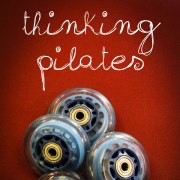Ep 34: Brain, Mind, Body – The Missing Pieces w/ Anne Bishop
Podcast: Play in new window | Download
Subscribe: Apple Podcasts | RSS
 What’s your brain got to do with it? What is your mind?
What’s your brain got to do with it? What is your mind?
We are taught that Pilates is a body, mind, spirit approach, but one sometimes wonders (in my case a lot of the time) where the mind and spirit fits in when we were being taught.
Our podcast guest, Anne Bishop, founder of Body Brain Connect, is going to help us gain some insight into just how the brain fits into our mind/body approach and I dare say clear a more wide open path to spirit — in that trifecta.
The brain we really just don’t talk about. As for spirit…
We’re often told that the spirit part is subtle, an undertone, not something to be talked about overtly or directly because it’s too out of our scope, or because people are uncomfortable with the idea of what spirit might mean. It’s unfortunate that they’re not totally wrong when it comes to the latter part. However, Anne helps us find a way to connect the brain and the mind with the body in a way that is not only clear and concise, but incredibly powerful.
Hope this blows your mind, changes your movement and elevates your spirit!
Enjoy.
Heroes
Our “hero” this week is Vanessa Rodriquez, author of the book “The Teaching Brain: An evolutionary trait at the heart of education.” This book was recommended to me by Anne and it’s also one of the required reading texts for the Master’s Program. AND it’s utterly insightful and delightful.
One of the stand out points for me in this book is how the author explores the importance of awareness of self and others in the teaching paradigm. She lists 5 areas of awareness that are critical for cultivating your craft and becoming an expert teacher. She calls them the Five Awarenesses of The Teaching Brain and they are:
- Awareness of self as a teacher
- Awareness of learner
- Awareness of interaction
- Awareness of context
- Awareness of teaching practice
Here’s a tidbit from the book for you to enjoy:
She’s quoting Sanjoy Mahajan in this first paragraph:
‘Deliberate practice requires sustained concentration, and the rewards are subtle and apparent only in the long term. Thus, one needs motivation in order to enter into and sustain the hard work of deliberate practice. But the learning happens not simply through putting in the hours, but through doing so intelligently.”
In the most basic way, expert teachers are deliberate about how they reflect on their practice. They are aware of the multiple areas that they must consider in order to hone their craft: the learner, the interaction, the context, their teaching practice, and their overall lens as a teacher. Expert teachers ask themselves: “Why did I become a teacher? What are my assumptions about teaching? How do I approach teaching? What do I expect to get out of this enterprise?”
Wow!!! So good!
I hope you’ll check out this wonderful HERO! Here’s where you can pick up the book: http://www.teachingbrain.org/
Pro Tip
Thanks to Anne, we have a wonderful teaching tool called Visual Enhancement of Touch (VET) based on her work with bridging the gap between brain research and movement practice. This is a tool that Anne introduced to the Skillful Teaching Mentoring cohort last January and not only has it been helpful to me in my teaching of teachers, but to the teachers working with students a all stages.
Here’s how Anne first introduced the technique, although you can use it ANYTIME, ANYWHERE, with ANY EXERCISE.
Teaching/Informing Neutral Spine:
From your normal supine hook-lying position (the most common place for us to teach neutral spine) here’s what you do:
- Students place their own hands on the ASIS
- Cue them to rock the pelvis from 6 o’clock to 12 o’clock (anterior/posterior tilting), making sure to tune them into the outer sensations of their pelvis and back touching or not touching the floor, movement under their fingertips, areas of tightness, effort etc.
- Then have them curl up just enough so that they can SEE their hands on their pelvis and continue the rocking.
- Cue them to notice what it feels like when it looks a certain way. Where is their body in space when they experience a certain sensation. Trying to draw their attention to the visual experience while coupling the more felt experience (bridging the gap between seeing and feeling = enhanced proprioception)
This VET can be done standing as well. One of my favorite ways to teach finding neutral is to have a student place their hands on their ASIS as above, but stand perpendicular to a mirror. They rock their pelvis as before but now turn their head to SEE what the body looks like as they experience what it feels like both from their hands and tracking any “felt sense.”
I tend to use a mirror A LOT for these purposes and get the students to inquire about what they’re experiencing as they move vs what they’re seeing as they move. I find this has a tremendous impact on their spatial awareness as well as their ability to formulate more articulate questions and problem solve for themselves. In short, you’re empowering them to discover their bodies for themselves rather than depending on you to always TELL THEM.
Links and Resources
Learn More About Body Brain Connect & Anne Bishop M. Ed
Learn More About The Science & Psychology of Teaching Master’s Program
Connect With Us
- Email us at thinkingpilatespodcast@gmail.com or use the form below.
- Find us on Facebook at The Thinking Pilates Podcast
Reach us Individually
- Chantill – chantill@skillfulteaching.com
- Phone – (707) 738-7951
- Debora – dkolwey@gmail.com



 How are you showing up? Why are you showing up? Why do you teach? What IS teaching? Why do you care? This is Skillful Teaching: A Whole-person approach to being an expert teacher, not an expert technician. There's a difference. Want to know what it is?
How are you showing up? Why are you showing up? Why do you teach? What IS teaching? Why do you care? This is Skillful Teaching: A Whole-person approach to being an expert teacher, not an expert technician. There's a difference. Want to know what it is?

Leave a Reply
Want to join the discussion?Feel free to contribute!